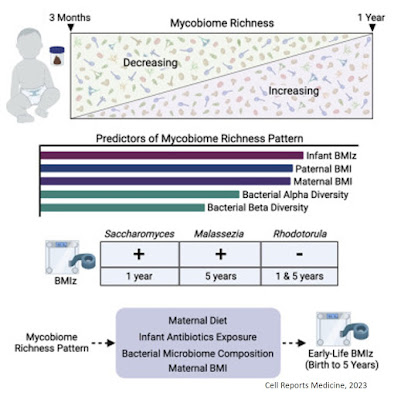Researchers have
found a link between the diversity, or number, of fungal species in the
infant gut and the body-mass index (BMI) of infants.
“The
pattern of fungal diversity was being reflected in the metabolism, or
the body weight, of these children,” says the principal investigator on
the study. “This study sheds new light on some of the factors in the
infant microbiome that influence a child’s metabolic health.”
Along
with changes in fungal diversity, the study found other contributing
factors related to infant BMI. These included the BMI of the mother as
well as her diet, exposure to antibiotics, and bacterial diversity in
the infant gut. Many studies have shown that bacteria in the intestinal
microbiome – the community of microbes that live in the human gut – play
an important role in metabolism. Research has found strong associations
between infant gut microbiome composition, infant growth trajectories,
and the risk of becoming overweight or obese. However, little is known
about the role that fungi, also known as the mycobiome, play in early
childhood health and development.
“This
is the first study that we know of to show specific types of gut fungi
play a role in weight gain and growth in early childhood,” says a
co-first author on the study. “Our findings suggest gut fungi may have
important influences on early childhood development, highlighting the
need for more research focused on the role of gut fungi in human health
during the first years of life.”
The study published in Cell Reports Medicine included 100 infants enrolled in the CHILD Study. The
study was not designed to and did not show a cause-and-effect between
infant gut fungal diversity and a child’s risk of becoming overweight or
obese.
“It
is still too early for the study’s findings to be translated into
health care recommendations,” says the other co-first author on the
study. “It will be important for our findings to be explored in other
infant cohort studies in other locations around the world, to determine
if these findings were specific to our cohort or if they are consistent
in other populations as well.”
https://www.cell.com/cell-reports-medicine/fulltext/S2666-3791(23)00020-4
http://sciencemission.com/site/index.php?page=news&type=view&id=publications%2Fmaturational-patterns&filter=22

